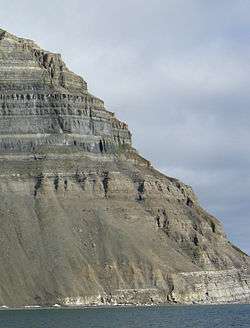Law of superposition
The law of superposition is an axiom that forms one of the bases of the sciences of geology, archaeology, and other fields dealing with geological stratigraphy. It is a form of relative dating. In its plainest form, it states that in undeformed stratigraphic sequences, the oldest strata will be at the bottom of the sequence. This is important to stratigraphic dating, which assumes that the law of superposition holds true and that an object cannot be older than the materials of which it is composed.
History
The law of superposition was first proposed in 1669 by the Danish scientist Nicolas Steno.[1] In the English-language literature, the law was popularized by William "Strata" Smith, who used it to produce the first geologic map of Britain.[2] It is the first of Smith's laws.
Archaeological considerations
Superposition in archaeology and especially in stratification use during excavation is slightly different as the processes involved in laying down archaeological strata are somewhat different from geological processes. Man-made intrusions and activity in the archaeological record need not form chronologically from top to bottom or be deformed from the horizontal as natural strata are by equivalent processes. Some archaeological strata (often termed as contexts or layers) are created by undercutting previous strata. An example would be that the silt back-fill of an underground drain would form some time after the ground immediately above it. Other examples of non vertical superposition would be modifications to standing structures such as the creation of new doors and windows in a wall. Superposition in archaeology requires a degree of interpretation to correctly identify chronological sequences and in this sense superposition in archaeology is more dynamic and multi-dimensional.
See also
| The Wikibook Historical Geology has a page on the topic of: Steno's principles |
- Harris matrix
- Principle of cross-cutting relationships
- Principle of faunal succession
- Principle of lateral continuity
- Principle of original horizontality
- Stratification (archeology)
- Stratigraphy
- Structural geology
References
- David Thomas, Robert Kelly, Archaeology, p. 153, Cengage Learning, 2005 ISBN 0155058991.
- Patrick Wyse Jackson, The Chronologers' Quest: The Search for the Age of the Earth, Cambridge University Press, 2006 ISBN 1139457578, pp.127-8.
General sources
- Hamblin, W.K. The Earth's Dynamic Systems: A Textbook in Physical Geology, by W. Kenneth Hamblin, BYU, Provo, UT, Illus. William L. Chesser, Dennis Tasa, (Burgess Publishing Company, Minneapolis, Minnesota), c 1978, pg. 115, "The Principle of Superposition and Original Horizontality;" pg. 116: The Law of Faunal Succession, "The Principle of Crosscutting Relations;" pg 116-17: "The Principle of Inclusion," (as in the Steno discussion above).
- Principles of Archaeological Stratigraphy. 40 figs. 1 pl. 136 pp. London & New York: Academic Press ISBN 0-12-326650-5
